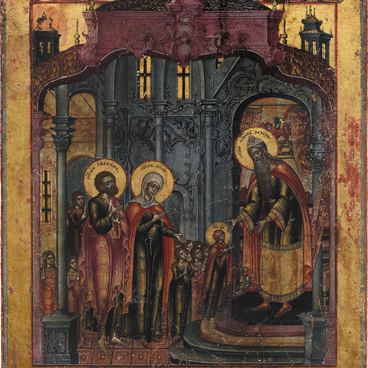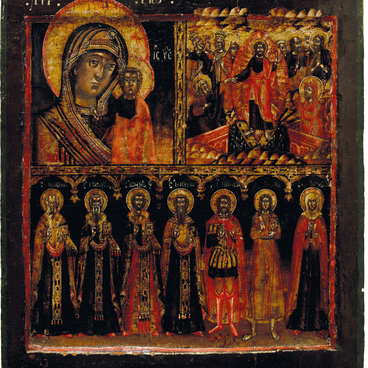The Resurrection – The Descent into Hell is a festive icon. It is dedicated to the main event of the Christian New Testament history — the Resurrection of Christ. Christ is depicted here twice. In the lower right corner, surrounded by an oval halo, mandorla, He emerges from the tomb, in front of which lie a thrown gravestone and sleeping warriors. In the centre, Christ, in the same single-tone clothes, tramples the hell gates crossed over the abyss.
The Resurrection – The Descent into Hell
Creation period
Late 19th – early 20th century
Dimensions
109x87x3,8 cm
109х87х3.8 cm
109х87х3.8 cm
Technique
Wood, (panel made of three pieces with kovcheg), inserted opposed battens (the bottom one is lost). Pavoloka, levkas, tempera, gilding
Collection
Exhibition
0
Open in app#3
Unknown Author
The Resurrection – The Descent into Hell
#2
#6
This icon was painted in the late 19th — early 20th century, possibly in Moscow. There were options of how to depict the narrative of the Resurrection of Christ, the icon painter here was guided by the one known from the middle of the 16th century. According to it, the scene The Rise from the Tomb is placed in the lower right corner, and not at the top centre, as is customary in later icons. At the same time, the image of Christ himself in the halo of the almond-shaped mandorla with the soldiers sleeping around came from Russian art of the second half of the 17th century. Another peculiarity of this icon: the master did not inscribe the names of the saints depicted here.
#7
In the central part of the icon, Christ is bent over Adam and leads him out of hell, holding him with His right hand by the wrist. There is a scroll in his left hand, and a himation cloak rises over his back. The robe of Christ is painted with the so-called assist or touches of gold leaf.
Behind the figure of Adam stand Eve and one of the righteous Myrrhbearers. Behind them is the first New Testament prophet John the Baptist and the Old Testament kings David and Solomon in coronation clothes.
Behind the figure of Adam stand Eve and one of the righteous Myrrhbearers. Behind them is the first New Testament prophet John the Baptist and the Old Testament kings David and Solomon in coronation clothes.
In the next row are three young prophets in red caps with white headbands.
To the right of Christ, Moses, with the Tablets in his hands, addresses an unknown prophet. Under Jesus’s feet in the black cave of hell, angels fetter Satan, and at the top of the icon an angel with spread wings holds the Golgotha cross, a symbol of victory over hell and death.
#8
In the canonical Gospels, the Resurrection of Christ is communicated implicitly: by the descriptions of an earthquake, the empty tomb of Christ, the appearance of angels to the Myrrhbearers. Stories about how Christ fettered Satan and brought the Old Testament righteous, led by Adam and Eve, out of hell formed from the apocryphal Gospel of Nicodemus of the 2nd century, as well as individual psalms, prophecies, Epistles of the Apostles, the words of the Church Fathers and liturgical texts.
#9
109х87х3.8 cm
read morehide
00:00
00:00
1x
The Resurrection – The Descent into Hell
Creation period
Late 19th – early 20th century
Dimensions
109x87x3,8 cm
109х87х3.8 cm
109х87х3.8 cm
Technique
Wood, (panel made of three pieces with kovcheg), inserted opposed battens (the bottom one is lost). Pavoloka, levkas, tempera, gilding
Collection
Exhibition
0
Open in app
Share



